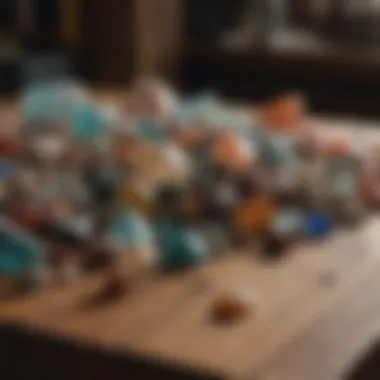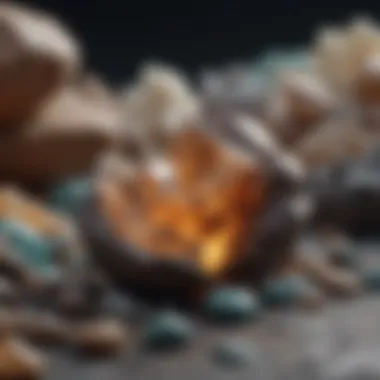Determine Your Minerals: A Complete Identification Guide


Intro
Identifying minerals can be both a scientifically engaging and personally rewarding hobby. This guide aims to arm you with the necessary skills and knowledge to effectively determine the types of minerals in your collection. The process is systematic and involves assessing physical properties, conducting simple tests, and referencing various resources. Whether you are venturing into this field for educational, collectible, or personal interests, understanding how to identify minerals enriches your experience.
History and Origins
Overview of Collectibles, Rocks, and Fossils
The passion for collecting minerals, rocks, and fossils dates back centuries. Humans have been fascinated by natural wonders since ancient times. This fascination led to early forms of classification and documentation. Many cultures revered these earthly treasures, attributing various characteristics and powers to them. Today, the act of collecting these items has evolved, yet the foundational curiosity remains.
Rocks and fossils also provide invaluable insight into the Earth's history. Fossils, for instance, reveal the existence of ancient life forms and ecosystems, allowing geologists and paleontologists to piece together past environments. Minerals, on the other hand, form through geological processes over millions of years, revealing information about the earth's conditions and changes.
Historical Significance and Cultural Impact
Throughout history, crystals and minerals have held significance in mythology and healing practices. From the ancient Egyptians who used lapis lazuli in decorative artifacts to the Buddhists who meditate with quartz crystals, the impact reaches far and wide. Each culture possesses a unique narrative surrounding specific minerals that reflects its values and beliefs. Understanding this historical context can deepen one’s appreciation of these natural resources.
"The history of mineral collecting offers insights not only into science but also into human culture and belief systems."
Identification and Classification
Guide to Identifying Rocks and Fossils
The first step in identifying minerals is to observe their physical characteristics. Focus on attributes such as color, luster, hardness, and streak. Utilizing Mohs scale of hardness is an excellent starting point. It rates ten minerals from talc (softest) to diamond (hardest). Scratch tests can help discern where a specific mineral falls on this scale. Additionally, examining fractures, cleavage, and crystal forms provides clues to a mineral's identity.
Conducting simple acid tests can be useful for distinguishing carbonates from other minerals. A few drops of hydrochloric acid on a sample can reveal effervescence, indicating a carbonate mineral.
Common Types and Variations
When it comes to minerals, diversity is immense. From feldspar to quartz, each type has numerous variations. It is essential to familiarize yourself with common minerals and their identifying features.
- Quartz: It is highly abundant and can be clear or take on shades of colors.
- Feldspar: Characterized by its crystalline structure, typically pink, white, or grey.
- Calcite: Often found in sedimentary rock and exhibits effervescence when tested with acid.
Recognizing these variations and understanding their environments can significantly aid in the identification process.
This comprehensive guide will continue by exploring additional techniques and resources for mineral classification. Each section will build on the foundational knowledge established here, providing the tools you need to deepen your understanding and hone your skills in mineral identification.
Prelims to Mineral Identification
Identifying minerals is a crucial skill for enthusiasts, collectors, and students alike. Understanding the specific properties and characteristics of minerals allows for accurate classification and appreciation of their uniqueness. This knowledge supports not only personal exploration but also contributes to scientific inquiry and education. When individuals identify minerals, they gain insight into geological processes, environmental conditions, and even historical context.
Importance of Identifying Minerals
Identifying minerals carries significant implications for various fields. For collectors, it enhances the value and enjoyment of a collection. Knowing the exact type of mineral ensures better care and preservation methods, while also helping to connect with others who share similar interests. In academia, mineral identification is foundational. Geologists and earth scientists rely on precise identification to study geological formations, natural resources, and the planet's history. Furthermore, it fosters environmental awareness as individuals learn about the materials that constitute the Earth.
The importance of accuracy cannot be overstated. Misidentification can lead to flawed conclusions in scientific studies or reduced value in a collector's portfolio. Thus, a thorough understanding of mineral characteristics is vital for anyone engaged in this endeavor. Special attention to the nuances of each mineral enables enthusiasts to communicate effectively within the community, whether in local clubs or on online forums.
Overview of Mineral Characteristics
Minerals possess distinct characteristics that serve as their identifiers. These characteristics encompass both physical and chemical aspects, each contributing essential information for identification. Physical properties often include color, streak, luster, and hardness, while chemical properties typically involve reactivity and specific tests like the acid test.
- Color: This is the most immediate characteristic but can be misleading due to variations caused by impurities.
- Streak: The color of a mineral's powder can often differ from its external hue, making this test a reliable indicator.
- Luster: This defines how light reflects off a mineral's surface, categorized as metallic, glassy, pearly, and other types.
- Hardness: This is determined using the Mohs scale, which ranks mineral hardness from 1 (talc) to 10 (diamond).
Chemical attributes may include:
- Reactivity: Some minerals may react with hydrochloric acid, a distinctive feature for identification.
- Acid Test: This is a straightforward method used to observe fizzing, indicating the presence of carbonates.
Overall, recognizing these characteristics is the first step in accurate mineral identification. As enthusiasts dive deeper, they learn to appreciate the complexity of these natural substances. This exploration can be both enriching and satisfying.
Basic Properties of Minerals
Understanding the basic properties of minerals is essential for accurate identification. These properties offer fundamental clues about a mineral’s nature and help differentiate one type from another. It assists collectors, students, and enthusiasts in forming a solid foundation for further analysis. A grasp of mineral properties gives insight into their formation, uses, and significance in geology. Several distinct properties are observed in minerals – physical and chemical. Each offers unique advantages when applied in identification processes.
Physical Properties
Color
Color is often the first characteristic noticed when encountering a mineral. It plays a significant role in initial identification. Many minerals may have distinct colors that can assist in distinguishing them from similar looking specimens. However, relying solely on color can be misleading. For example, quartz can appear in various shades including clear, purple, and smoky. This variability makes it less dependable on its own.
Key points about color:
- Not always consistent: A mineral can show color variation due to impurities.
- Useful for grouping: Can help categorize minerals into broader groups.
In summary, while color is beneficial for first observations, it should be used alongside other properties for classification.


Streak
The streak test involves rubbing a mineral against a porcelain tile. This procedure reveals the true color of the mineral in powdered form. Streak is more reliable than color alone. For instance, hematite appears metallic gray but gives a reddish streak. This defined property serves as a strong characteristic for mineral worshippers.
Key aspects of Streak:
- Consistent result: Unchanging compared to raw mineral color.
- Critical for identification: Can lead to accurate acknowledgment of certain minerals.
By applying the streak test, enthusiasts obtain a clearer representation of a mineral's identity.
Luster
Luster refers to how light interacts with the surface of a mineral. It can range from metallic to dull, glassy, or pearly. Observing luster is important because it provides distinctions. Apatite, for example, has a vitreous luster, making it standout compared to other minerals.
Characteristics of Luster:
- Variety: Includes metallic, resinous, and adamantine types.
- Identifying feature: Adds depth to identification and classification.
Understanding luster enriches the identification process by revealing how minerals shine. This property can clarify many complexities involved in mineral identification.
Hardness
Hardness measures a mineral’s resistance to scratching. The Mohs scale is often used for this purpose, ranking minerals from talc, which is soft, to diamond, which is the hardest. Knowing a mineral’s hardness can provide pivotal insights. For instance, a hardness of 7 indicates a mineral can scratch glass.
Key features of Hardness:
- Scale utilization: The Mohs scale is a practical and accessible tool.
- Recommendations for testing: Advises enthusiasts on tools needed for precise identification.
Thus, this property is vital in differentiating minerals that may seem identical otherwise.
Chemical Properties
Reactivity
Reactivity indicates how a mineral interacts with other substances. Some minerals react with acids, while others remain stable. For instance, calcite fizzes when exposed to hydrochloric acid, which points to its carbonate composition. This test provides critical information in determining a mineral’s identity.
Benefits of studying Reactivity:
- Relational understanding: Aids in understanding mineral classifications.
- Chemical knowledge: Requires little equipment beyond simple acids for practical tests.
Utilizing reactivity as a property can significantly narrow down the possibilities for identification.
Acid Test
The acid test specifically refers to the practice of applying hydrochloric acid to a mineral sample. With certain minerals, this test can reveal significant reactions. For example, limestone fizzes in the presence of acid, indicating calcium carbonate. This property is thus invaluable in the identification process because it reflects specific chemical characteristics.
Features of Acid Testing:
- Direct and straightforward: Simple process for identifying reactive minerals.
- Versatile application: Helpful for both beginners and experienced collectors.
Tools for Mineral Identification
In the exploration of minerals, having the right tools is crucial for accurate identification. These tools enhance the process by allowing enthusiasts to conduct physical examinations and tests. The following sections will detail essential devices and technological aids that can significantly facilitate the identification process.
Essential Tools Required
Hand Lens
A hand lens, often known as a jeweler's loupe, is a fundamental tool in mineral identification. Its primary purpose is to magnify the mineral's surface, allowing for a closer examination of its texture and details. The key characteristic of a hand lens is its power, usually ranging from 10x to 20x magnification. This makes it a popular choice for enthusiasts who want a clear view of crystal formations and markings.
One unique feature of a hand lens is its portability, making it easy to carry during field trips. However, the disadvantage lies in the need for stable hands to maintain focus, which can be challenging in outdoor environments.
Hammer
A hammer is an essential tool for anyone involved in mineral identification. It is primarily used to break minerals to examine their internal structure. The key characteristic of a hammer in this context is its robustness. A geological hammer is specifically designed for this purpose, with a flat face on one side and a pick on the other. This versatility makes it a beneficial choice for both amateurs and professionals.
One unique feature of the hammer is its dual functionality, enabling the user to not only break rocks but also dig around them. However, the risk of damaging specimens is a concern, thus necessitating careful handling.
Scratch Kit
A scratch kit is another critical tool for identifying minerals through hardness tests. It typically includes a series of materials with different hardness levels. The key characteristic of a scratch kit is its ability to help determine a mineral's ranking on the Mohs hardness scale. This tool is beneficial due to its simplicity and effectiveness in providing quick results.
A unique feature of a scratch kit is its portability, allowing users to carry it along while exploring. However, it may not cover every possible hardness level, which could limit some assessments.
Utilizing Technology


Technology has become a crucial component in mineral identification. It enhances accuracy and efficiency, allowing enthusiasts to tap into vast resources easily. The following sections will explore various technological tools available today.
Mobile Apps
Mobile applications designed for mineral identification can transform how enthusiasts interact with their specimens. The key characteristic of mobile apps is their accessibility, providing users with databases and identification guides right at their fingertips. This makes them particularly popular among hobbyists and collectors who require quick references.
A unique feature of many mobile apps is their capability to use image recognition technology, enabling users to take a photo of a mineral and receive instant feedback. Despite these advantages, the accuracy of results can vary depending on the app's database and algorithms.
Online Databases
Online databases serve as a comprehensive library for mineral identification and research. The key characteristic of these resources is their extensive catalog of minerals and their properties. Such databases are beneficial for collectors seeking to expand their knowledge for accurate identification and comparison purposes.
One unique feature of online databases is the community support often included, allowing users to share experiences and findings. However, the challenge lies in navigating these databases, as the vast amount of information can be overwhelming for beginners.
Conducting Visual Observations
Visual observation is a fundamental step in mineral identification. This process relies on basic yet powerful techniques that provide initial clues about a mineral's identity. Observing visual aspects of a mineral can quickly narrow down possibilities, guiding the collector towards a more precise identification. Examining color, form, luster, and transparency offers insight into the mineral's characteristics that cannot be assessed through other means. Thus, mastering visual observation is invaluable.
Examining Color and Form
Color is often the first characteristic that one notices in a mineral. However, it is important to remember that color alone can be misleading. Many minerals exist in a range of colors due to impurities or structural conditions. For instance, quartz can be clear, rose, or smoky. Hence, while color is a starting point, it should not be the sole criterion for identification.
When examining form, collectors should consider the mineral's crystal habit or shape. Some minerals crystallize in specific forms; for example, pyrite typically exhibits cubic crystals whereas calcite may show rhombohedral shapes. Observing features such as growth patterns or natural facets can add clues to the identification.
In summary, when documenting observations on color and form, collectors should aim to be specific, noting any peculiarities or variations. Tolerance for discrepancies is also necessary, as many minerals can occur in multiple varieties.
Identifying Luster and Transparency
Luster describes how a mineral interacts with light, providing critical insight into its identification. It can be categorized as metallic, glassy, pearly, or dull among others. For example, galena has a metallic luster while talc presents a greasy sheen. Knowing the type of luster can significantly narrow down potential candidates.
Transparency is equally telling, concerning how much light passes through the mineral. Rocks fall into three categories: transparent, translucent, or opaque. This property can differentiate minerals, as some are exclusively transparent, while others like hematite are opaque.
Luster and transparency offer a window into the mineral's nature, often leading to quick identification. Fine-tuning these observations is vital.
Performing Basic Tests
Performing basic tests is a critical aspect of mineral identification. These tests allow enthusiasts to analyze mineral samples with quantifiable and observable attributes. Basic tests create a structured approach to differentiating minerals and can yield reliable results in various circumstances. Using objective assessments instead of subjective observations aids in minimizing errors and enhancing accuracy.
By gaining a deeper understanding of your mineral's properties through specific tests, you can build a comprehensive picture of its identity. This process often means relying on tools and methods that are both practical and accessible. Examining the hardness and chemical reactions of minerals reveals much about their structure and composition.
Conducting Hardness Tests
Hardness tests serve as an essential method for evaluating minerals. The duration of a mineral's resilience against scratching provides a clear indicator of its identity. One of the most renowned scale systems is the Mohs Hardness Scale, which categorizes minerals from 1 (talc) to 10 (diamond). By utilizing this scale, you can predict what other minerals your specimen may be similar to.
To conduct a hardness test:
- Gather a set of reference minerals with known hardness values. Common items include a fingernail (about 2.5), a copper coin (3.0), or glass (5.5).
- Begin by scratching the specimen gently with the reference materials.
- Record the result. If the sample scratches or is scratched, note the hardness level.
This systematic approach allows for straightforward identification, especially when larger groups share similar qualities.
Evaluating Reaction to Acids
Acid reactions provide significant insights during mineral evaluations. Some minerals react distinctly to acids, especially hydrochloric acid, which can help in categorizing specific carbonates. For instance, calcite will effervesce vigorously upon contact with acid, while quartz will show no reaction.
To test:
- Use a dropper to place a few drops of acid on the mineral surface. Ensure safety precautions, such as wearing gloves and goggles.
- Observe any fizzing or bubbling, indicating a reaction.
- Document the reaction type, intensity, and duration.
This test is crucial for defining minerals like limestone and dolostone, which show differential reactions. The results can guide you in narrowing down your options, assisting in a precise determination of your mineral's composition.
Remember, careful documentation and systematic testing are the keys to successfully identifying minerals.
Using Reference Materials
In the pursuit of mineral identification, utilizing reference materials is invaluable. Such resources provide guidance and detailed information that can facilitate the understanding of complex mineral traits. The richness of the data offered by guidebooks, online platforms, and community forums can make the identification process more efficient and accurate. This section explores how these resources can enhance your mineral identification journey.
Guidebooks and Field Guides
Guidebooks and field guides serve as essential companions for anyone interested in mineral identification. These printed materials are often written by geologists and mineralogists, offering insights into mineral characteristics, local geology, and identification procedures. When selecting a guidebook, consider the following:
- Depth of Information: Choose a guide that provides detailed descriptions of minerals, along with illustrations. A comprehensive guide will cover essential aspects such as hardness, color, reaction to acid, and more.
- Local Relevance: Many guidebooks focus on specific regions or types of minerals. Selecting a field guide that corresponds to your geographic location can greatly enhance your understanding of which minerals you are likely to encounter.
- User-Friendly Layout: Look for guides with clear organization and index systems. Being able to quickly find relevant information is crucial when out in the field or examining your collection.
These guides not only help in identifying minerals but also educate users on the formation processes and uses of different minerals. Therefore, investing in a quality guidebook can pay dividends in both educational and practical terms.
Online Resources and Forums


The Internet has revolutionized access to information about minerals. Numerous online resources and forums provide platforms for both novice and experienced collectors. Here are some key benefits:
- Accessibility and Convenience: Websites like Wikipedia and Britannica contain robust articles on various minerals. Furthermore, many forums encourage sharing of insights, questions, and experiences among collectors.
- Community Support: Platforms like Reddit have dedicated subreddits where individuals can post images of their minerals to get feedback from knowledgeable members. This reciprocal learning fosters a deeper understanding of mineral characteristics and identification techniques.
- Regular Updates: Unlike a printed book, online content can be routinely updated. Thus, keeping abreast of the latest discoveries, methods, and insights becomes more manageable.
Overall, engaging with online communities and leveraging their collective knowledge can considerably enhance one's ability to identify minerals proficiently. By actively participating, users can evolve and adapt their identification strategies, ultimately leading to a more informed collecting experience.
"An informed collector is a successful collector."
Utilizing various reference materials, both in print and online, equips enthusiasts with the necessary tools to accurately determine the minerals they encounter. Whether you are on a field trip or analyzing specimens at home, these resources will enhance your efforts and deepen your appreciation of the mineral world.
Engaging with the Community
Engaging with the community plays a crucial role in the journey of mineral identification. It offers individuals not only support but also a wealth of knowledge that can enrich their understanding of minerals. Being part of a community can provide different perspectives and access to resources that one might not find alone. Collaboration among enthusiasts fosters an environment where sharing experiences leads to personal growth in knowledge and skills. This aspect is vital because mineral identification is often not a solitary endeavor; finding companions in this exploration makes the process much more enjoyable.
Joining Collectors’ Groups
Joining collectors’ groups can greatly enhance your mineral identification skills. These groups often comprise diverse individuals, from beginners to experts, who share a common passion. Many local chapters exist, and they organize regular meetings, field trips, and exhibitions. Participating in such events can expose you to various types of minerals, boosting your ability to recognize different specimens.
Moreover, collectors’ groups often have access to experienced mentors. These individuals can provide guidance on specific identification techniques that are not always available in books or online resources. Additionally, being part of a group offers opportunities to exchange minerals, which can enhance your collection significantly.
- Access specialized tools that you may not own.
- Learn about the geology of local areas through guided field trips.
- Experience the joy of discovering together with fellow enthusiasts.
Participating in Online Discussions
Participating in online discussions can expand your horizons in mineral identification. Various platforms offer forums where you can pose questions, share your findings, and get advice from others who share your interest. Websites like Reddit and specialized mineral groups on Facebook foster vibrant discussions where members showcase their discoveries and provide insights based on their experiences.
Through these digital discussions, newcomers can learn from established enthusiasts. Members often share valuable resources such as links to research articles, videos, or even tutorials on conducting tests. This exchange isn't just beneficial for lesson-sharing; it also creates a sense of camaraderie and community spirit in the realm of mineralogy.
"Engagement with both local and online communities is the backbone of continuous learning in mineral identification."
By making connections in both spaces, you ensure that your growth as a mineral enthusiast is steady and informed. Connecting with others opens up new avenues for learning that can take your mineral-collecting efforts to new height.
Documenting Your Findings
Documenting your findings is a crucial part of mineral identification. It allows collectors to keep track of their specimens, record observations, and analyze data over time. By maintaining a structured log, you will have a systematic way to evaluate the minerals in your collection or those you encounter in the field. This not only enhances your understanding but also adds value to your hobby.
Keeping a Mineral Log
A mineral log is a detailed record of your mineral discoveries. It serves multiple purposes. First, it helps in organizing your findings. You can note down where each specimen was found, its physical and chemical properties, and any tests conducted. This is particularly useful for later reference. For example, if you find a quartz specimen, noting the location and characteristics can help when comparing it to future finds.
Essential elements to include in your log:
- Date of discovery: Helps track your progress over time.
- Location: Documenting where you found the mineral can be crucial for future exploration.
- Description: Note color, weight, size, and other identifying features.
- Test results: Record any hardness tests, acid reactions or other analyses performed.
- Photos: Help provide visual references.
A clear and well-maintained mineral log can enhance your knowledge and aid in confirming mineral identifications.
Photographic Records
Photographic records complement your mineral log effectively. They serve as visual documentation of your specimens, capturing details that written descriptions may miss. High-resolution images can show texture, color variation, and any unique features, providing a reference that can be revisited easily.
When taking photographs:
- Use natural lighting: This minimizes shadows and color distortion.
- Include a size reference: This might be something as simple as a ruler or a coin.
- Capture multiple angles: It gives a complete view of the mineral's characteristics.
- Label images: Ensure each photo is labeled with relevant information, matching entries in your log.
Having these photographic records reinforces your log, offering an accurate visual reference that aids in future identifications or discussions with fellow collectors.
"Documentation is key in mineral collecting. It transforms mere collection into a valuable archive of knowledge."
With both a mineral log and photographic records, you will find your mineral identification efforts not only become more organized but also more enjoyable and educational.
The End
In the journey of mineral identification, concluding insights hold substantial weight. They synthesize the information and emphasize the significance of the techniques and tools outlined throughout the article. The conclusion serves not only to reiterate the essential steps taken but also to highlight the broader implications of effective mineral identification.
Summary of Key Steps
The process of determining your minerals is systematic yet engaging. Key steps include:
- Evaluating Physical Properties: The initial observations, such as color and luster, provide essential clues for identification.
- Conducting Basic Tests: Testing hardness and reaction to acids can further narrow down the possibilities and confirm suspicions.
- Utilizing Tools and Resources: Engaging with reference materials like guidebooks, mobile apps, and connecting with communities enables a much deeper understanding.
- Documenting Findings: Keeping track of discoveries not only enhances your knowledge base but also adds to your collection in a meaningful way.
These steps intertwine to create a comprehensive framework for mineral exploration and exalt the joy of discovery in each interaction.
Encouraging Continued Exploration
As the exploration of minerals concludes for now, it is imperative to carry the spirit of inquiry forward. Each mineral holds its own story, begging to be unveiled. Embracing this journey fosters a deeper appreciation for nature's artistry.
To truly excel in mineral identification, consider:
- Regular Practices: Revisit techniques and refine your methods with each new mineral.
- Engagement in the Community: Take part in local fossil and mineral shows or online forums like Reddit. Your engagement can provide insights and foster connections with fellow enthusiasts.
- Expanding Knowledge: Explore various geological formations and habitats to uncover new opportunities for discovery.
By maintaining curiosity and building knowledge, you will find the world of minerals infinitely rewarding. Continued exploration not only enhances your skills but also enriches your passion for geology and collecting.



